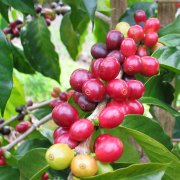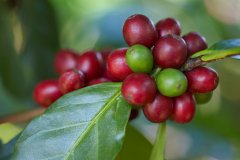Introduction to the Goddess Manor for the treatment of Yellow Honey in Costa Rica Coffee producing area
Las Lajas Estate Yellow Honey
Country: Costa Rica
Region: Central Valley
Class: SHB;
Processing method: yellow honey processing
Altitude: 1300~1500 m;
Breeds: Caturra, Catuai
Cupping Notes: Honey, Tropical Fruit, Maple Syrup,Melons Las Lajas Estate The annual production season from December to February, the owner insists on only harvesting ripe and red fruits, and most of the way to improve the sweetness and thickness of coffee, and placed in the African trellis-style sun field, to ensure that coffee can receive uniform sunlight, avoid excessive fermentation. At the same time, the estate has also actively obtained international organic certification. At present, it has passed the certification of international organic organizations such as USDA, JAS and NOP Las Lajas Estate, located in the central valley production area at the foot of Poás de Alajuela volcano. It has been operated by the estate owner Chacón family for more than 80 years. The estate has an altitude of 1300~1500 meters and an annual output of about 46000 kilograms. Costa Rica has many excellent production areas, while Costa Rica has a common understanding of quality. That is to require the use of mature coffee fruit to ensure the production of high-quality coffee.
Generally speaking, the post-processing of harvested coffee fruits uses a lot of water, but Costa Rica's advanced production equipment saves water resources to the greatest extent, and at the same time uses a circulating filter device to treat the wastewater from washing coffee beans, so that the wastewater is purified into clean water to prevent pollution of the local soil environment.
After the coffee fruit is peeled, the peel and pulp are recycled as feed for livestock or converted into organic fertilizer and coffee bean dryer fuel. It can be said that Costa Rica has complied with the requirements of preserving the natural environment in every process of coffee production.

Important Notice :
前街咖啡 FrontStreet Coffee has moved to new addredd:
FrontStreet Coffee Address: 315,Donghua East Road,GuangZhou
Tel:020 38364473
- Prev

Sumatra (Sumatra) gold manning has a very deep flavor and strong taste.
When it comes to Asian coffee, the first impression of coffee lovers is often calm and calm. Asian coffee is generally characterized by thick flavor, strong sweetness and round taste, but slightly flat aroma and brightness. It is precisely because of the heavy nature of Asian coffee that it is very suitable to be used as a base when making Italian coffee. Raw coffee beans in Asia are generally processed by wet or semi-wet methods.
- Next

The formula of Sulawesi mixed with Espresso has low acidity and high quality Asian boutique.
When it comes to Asian coffee, the first impression of coffee lovers is often calm and calm. Asian coffee is generally characterized by thick flavor, strong sweetness and round taste, but slightly flat aroma and brightness. It is precisely because of the heavy nature of Asian coffee that it is very suitable to be used as a base when making Italian coffee. Raw coffee beans in Asia are generally processed by wet or semi-wet methods.
Related
- Does Rose Summer choose Blue, Green or Red? Detailed explanation of Rose Summer Coffee plots and Classification in Panamanian Jade Manor
- What is the difference between the origin, producing area, processing plant, cooperative and manor of coffee beans?
- How fine does the espresso powder fit? how to grind the espresso?
- Sca coffee roasting degree color card coffee roasting degree 8 roasting color values what do you mean?
- The practice of lattes: how to make lattes at home
- Introduction to Indonesian Fine Coffee beans-- Java Coffee producing area of Indonesian Arabica Coffee
- How much will the flavor of light and medium roasted rose summer be expressed? What baking level is rose summer suitable for?
- Introduction to the characteristics of washing, sun-drying or wet-planing coffee commonly used in Mantenin, Indonesia
- Price characteristics of Arabica Coffee Bean Starbucks introduction to Manning Coffee Bean Taste producing area Variety Manor
- What is the authentic Yega flavor? What are the flavor characteristics of the really excellent Yejasuffi coffee beans?

